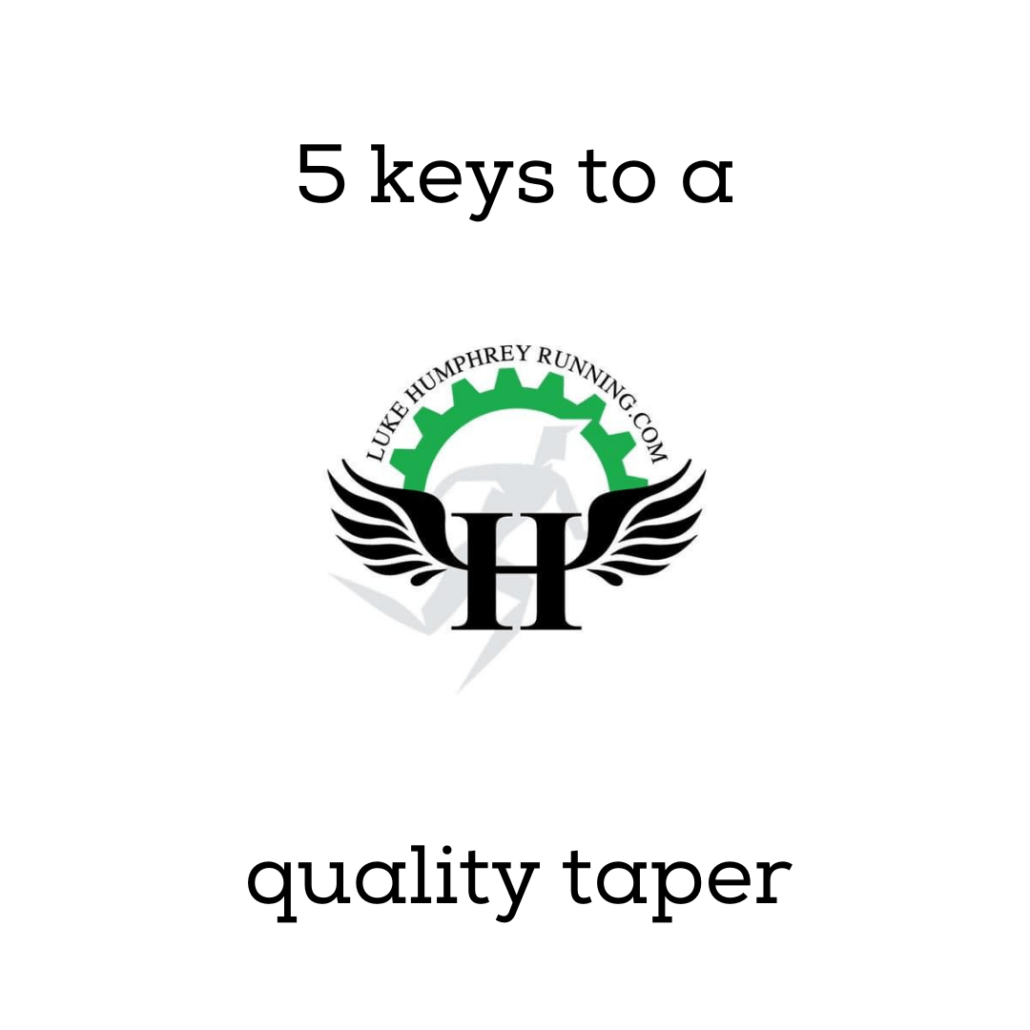5 Keys to a quality taper

Podcast: Play in new window | Download
One of the biggest complaints I get from athletes following the book (link), is that there is no taper. They say that because they are used to going from six days per week down to 4 and their mileage decreasing from 50 miles a week down to 20 miles a week and they don’t do any workouts for two weeks. When they see a taper like that in the HMM books, they panic. Don’t panic! Let’s take a look at the variables involved and what’s going on in the body. While a taper can be highly individualized to the athlete’s current situation, there are some keys that can be universally applied.
- Volume or Intensity
The common thing to do here is to cut both. By that, I mean what I discussed above. The daily volume is scaled back, the number of days is reduced, and the amount of intensity is scaled back (or removed altogether). Does this sound like you? Do you end up feeling sluggish rather than ready to rock? This could be a big reason why. The thing with the taper is that we are trying to balance recovery and performance increases against detraining from doing too little. While you may be able to do this for a short amount of time (a week maybe), many people attempt to do this for 2-4 weeks. With that amount of time, you cross over from elevating performance to detraining. While this isn’t extreme, just think of it this way- if you are willing to spend a big chunk of change on a shoe that will improve your performance by 1-3%, you certainly don’t want to give those gains away by going too hard on the taper!
Now, don’t take that as don’t cut volume for workouts and easy days. The same is true for the intensity. Find the balance that works best for you. If you find you really do need to cut back to extremes, then I would assess the training that takes you up to that point- especially if you never seem to perform to what your training suggests.
- Don’t change your routine
As Kevin and Keith Hanson always told us, the body craves consistency. Kevin would always make the analogy of sleep. If you are used to getting 6 hours of sleep and then all of a sudden you get 12, you tend to feel groggy the next day. We aren’t used to it. It can make us sluggish, make us feel heavy, and not ready to rock and roll.
My advice is that if you run 5 days a week, continue to do so. If you do two workouts a week, continue to do so. Let’s keep the routine the same and just scale back the volume.
- Analyze where you are at
As you enter the final stretch, it’s key to take an honest assessment of where you are at from a fitness standpoint. Look over your training- how much were you able to get in? Does it line up with your goals?
The big concern here is usually, “have I done enough?” As I write this, we are about six weeks out from the start of the fall marathon season and it has been HOT! So, what I hear now is big concerns over “weather” they can hit their goal pace since their workouts have either been a struggle to hit goal pace or were slow for a lot of the big workouts. I discuss this specific scenario in other writings, so I won’t address it here.
The big questions I would ask myself
- Did I miss any significant amount of time in the last 8 weeks (1+ weeks of training)
- Did I get the majority of the workouts in? (90%+ over last 8 weeks)
- Was I able to hit my paces (or weather adjusted) and recover between workouts?
- Get to the line
At this point, if I am looking at my schedule and thinking there is no way I can run what’s on it, then do what’s best for you. Don’t confuse that with just reverting back to old ways that never seem to work out for you. However, if you are just wiped out, nursing something that could end up worse if you keep pushing, or just trained over your head, then recover. Get to the line by any means necessary. For those in the marathon mastery course, go back to the recovery module and hit up all the modes you can in the last few weeks. This doesn’t mean you’ll make that original goal time, but you can give yourself a fighting chance.
- Don’t overcook yourself
If you are at a point where you don’t think you have done enough, now is not the time to try and cram the fitness in. I have tried it myself and it just makes things worse. In all honesty, being a little underprepared is better than being overcooked. If you are underprepared, you still have a shot at that homerun. This is especially true if you are a little more seasoned. However, if you are overcooked, there’s little chance you’ll be able to mentally or physically find what you need to pull through that performance.
At the end of the day, following these guidelines can help you individualize a taper that will work best for you. Whether you are using a plan from a book or online, you have to understand that the authors of the plan are trying to provide a template that will work for most people. So, it’s up to you to take the best information you can, mainly from your own body and training, so that you can apply specifics to the template. If you can do that, then you vastly increase your chances of nailing the taper and putting that hard-earned training to use.
Hey! If you enjoy my work- the blogs, the podcasts, being in the free communities answering questions, then please consider buying me a coffee! Your support goes a long way in allowing me to create more meaningful content and being active in the Facebook communities.




